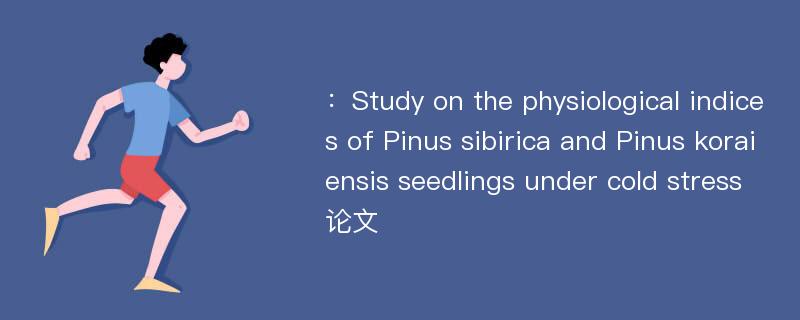
本文主要研究内容
作者(2019)在《Study on the physiological indices of Pinus sibirica and Pinus koraiensis seedlings under cold stress》一文中研究指出:Although Pinus sibirica and Pinus koraiensis are resistant to cold or low temperatures in the cold temperate regions of the northern hemisphere,the former has a stronger cold resistance.Research has been limited to the comparison of physiological responses of the two species to cold stress.In this study,5-year-old seedlings of P.sibirica and P.koraiensis were subjected to six temperature treatments,[20 ℃(control),0 ℃,-20 ℃,-40 ℃,-60 ℃,and-80 ℃],under different stress periods(6,12,24,and 48 h).The results showed that differences in each physiological index were significant between P.sibirica and P.koraiensis,except for the permeability of cell membranes,reactive oxygen species,proline and soluble proteins.An ANOVA test indicated that there were extreme differences among the temperatures for each index,stress time and temperature 9 time for most indices.All indices showed a similar trend for P.sibirica and P.koraiensis with decreasing temperature or the extension of stress time.Soluble sugars and proline increased at 0 to-20℃ and then remained unchanged with temperature decline.Other indices showed an increase from 20 to-20℃,stable from-20 to-40℃ and a decrease from-40 to-80℃.All the indices increased and then declined along with the prolonged cold stress time,except for the control.From 0 to-40℃,the permeability of cell membranes,relative conductivity,reactive oxygen species and malonaldehyde of P.koraiensis seedlings were higher than in P.sibirica,but superoxide dismutase,peroxidase,catalase activity and soluble sugars,proline,and soluble proteins content emerged as opposite.This study compared the physiological mechanism responses to cold stress between P.sibirica and P.koraiensis to provide the basis for the introduction,distribution,and genetic improvement of these coniferous species.
Abstract
Although Pinus sibirica and Pinus koraiensis are resistant to cold or low temperatures in the cold temperate regions of the northern hemisphere,the former has a stronger cold resistance.Research has been limited to the comparison of physiological responses of the two species to cold stress.In this study,5-year-old seedlings of P.sibirica and P.koraiensis were subjected to six temperature treatments,[20 ℃(control),0 ℃,-20 ℃,-40 ℃,-60 ℃,and-80 ℃],under different stress periods(6,12,24,and 48 h).The results showed that differences in each physiological index were significant between P.sibirica and P.koraiensis,except for the permeability of cell membranes,reactive oxygen species,proline and soluble proteins.An ANOVA test indicated that there were extreme differences among the temperatures for each index,stress time and temperature 9 time for most indices.All indices showed a similar trend for P.sibirica and P.koraiensis with decreasing temperature or the extension of stress time.Soluble sugars and proline increased at 0 to-20℃ and then remained unchanged with temperature decline.Other indices showed an increase from 20 to-20℃,stable from-20 to-40℃ and a decrease from-40 to-80℃.All the indices increased and then declined along with the prolonged cold stress time,except for the control.From 0 to-40℃,the permeability of cell membranes,relative conductivity,reactive oxygen species and malonaldehyde of P.koraiensis seedlings were higher than in P.sibirica,but superoxide dismutase,peroxidase,catalase activity and soluble sugars,proline,and soluble proteins content emerged as opposite.This study compared the physiological mechanism responses to cold stress between P.sibirica and P.koraiensis to provide the basis for the introduction,distribution,and genetic improvement of these coniferous species.
论文参考文献
论文详细介绍
论文作者分别是来自Journal of Forestry Research的,发表于刊物Journal of Forestry Research2019年04期论文,是一篇关于,Journal of Forestry Research2019年04期论文的文章。本文可供学术参考使用,各位学者可以免费参考阅读下载,文章观点不代表本站观点,资料来自Journal of Forestry Research2019年04期论文网站,若本站收录的文献无意侵犯了您的著作版权,请联系我们删除。
